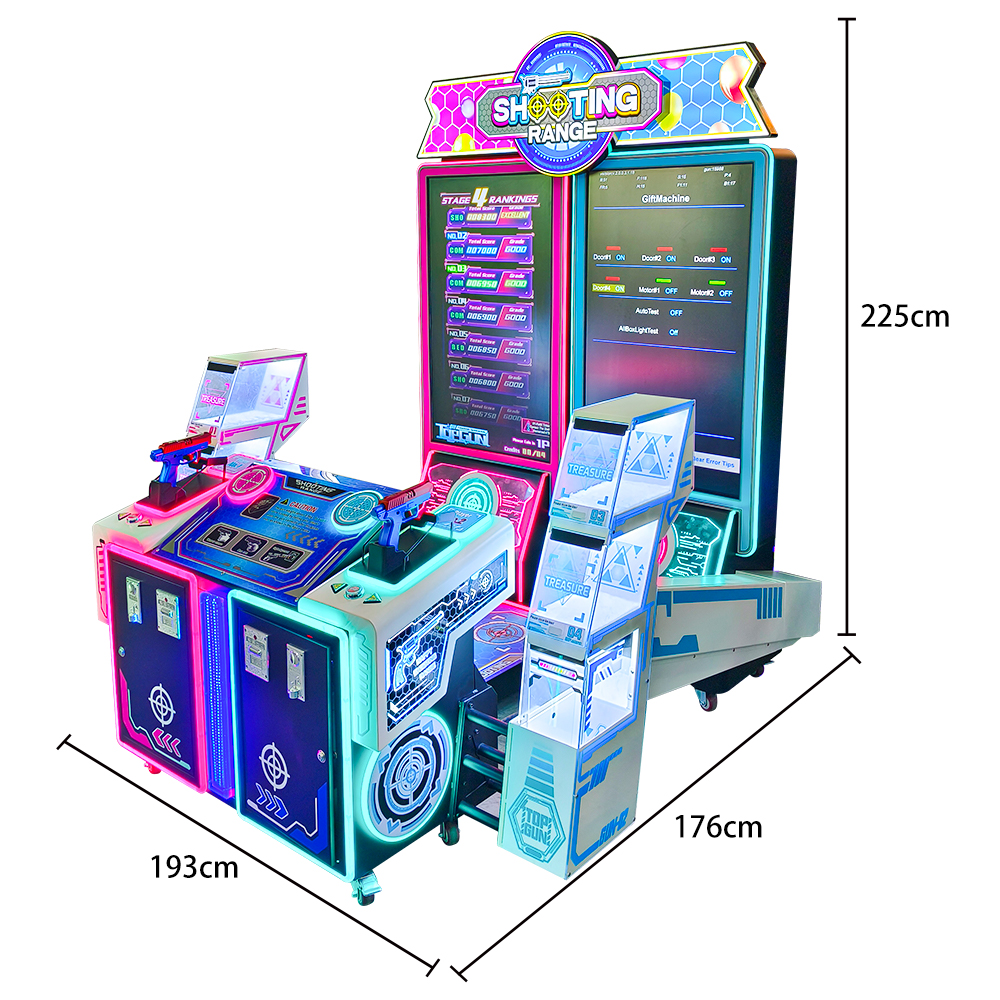Arcade games became popular due to their affordable entertainment, social hubs for interaction, and innovative technology like microprocessors enhancing gameplay.
Table of Contents
ToggleTechnological Innovation
The Beginning of Graphics & Sounds in Arcade Games
The stagefore to evolutionAt the inception of the 1970s, the technology behind the arcade games took a deep dive into evolvement. That lead to a primer, a push if you will, like those of Pong as the foundation for two-dimensional graphics, during this era eventually leading to vast new horizons. As the 1970s came to a close, the advent of Space Invaders ushered in more sophisticated graphics and the first sounds affected play in the game, would gaming to new levels of engagement. They weren’t just innovations; they were game changers, quite literally, leading players into the arcades.
The Role of Microprocessors and Hardware Advancements
Microprocessors helped usher in a golden age of arcade game technology. Before this time, games largely consisted of simple logic which was built upon general-purpose logic circuits. This trend started in and around 1978 when games such as Asteroids and PacMan were created with microprocessors offering a smoother game play and more intricate graphics. With these chips, games like Pac-Man could show off both highly detailed and vibrantly colored mazes and the first actual moving characters. The key point in the story came with the addition of microprocessors, which made it possible for developers to create incredibly complex games.
Advancements in Controls
A more important side of technological breakthrough with arcade video games would be the evolution of various handle techniques. While in the early games the Joysticks and buttons were raw and some appropriate combination of them, had to be done, but in subsequent series, games like Street Fighter took it to a higher level with intricate combination making it better and interesting (Street Fighter was way before that in mid 1980s.) The implementation of control devices such as trackballs and steering wheels in games like Marble Madness and Pole Position also broadened the arcade experience, offering an experience similar to real-life activities.
Multiplayer Gaming
In fact, the arrival of multiplayer tech was a literal game changer. The advent of multiplayer games that could be played on the same video console in arcades can be traced back to the 1985 launch of Gauntlet. This feature not only added a new level of play to the machines, but also increased the earning potential of the units. This turned the solitary arcade into essentially a multiplayer experience where players could play alongside each other.
From Pixels to 3D
With the advent of 3D graphics now a very real possibility thanks to the advancements made in arcade technology through the late 80s and early 90s, the likes of Virtua Racing and Virtua Fighter were at the forefront of the charge by the early 90s. This it accomplished by contending that, he release of these games wth polygonal 3D graphics made them seem more real and ht finally by immersng gamers in the chse and evasion of life-like rydia. It was possible thanks to the sophisticated glitch processing units that had been built for arcades, giving a level of detail and fluidity home consoles at the time could never have hoped to replicate.

Social Impact
Arcades as Cultural Hubs
In the 1980s, arcades were much more than places to play games; they were bustling social hubs where teenagers met up. American teenagers flocked to arcades in cities all over the country to play, to watch others play, and to socialize and compete. The air buzzed with blipping and beeping, and patrons were so animated that the laughter and conversation (even in a foreign language) was singing over whatever seed of music was playing. The culture helped legitimise video games as a serious form of entertainment.
Bridging Social Divides
Remember the arcades-the place we went to break through social barriers? Since they only required a quarter they were available to everyone, which helped them reach a wide demographic. There were a variety of people–from all walks of life and social statuses–shoulder to shoulder, day in and day out, all there for the same exact reason of either themselves or their loved one competing in this sport. This was important for such partaking in the gaming community allowed folks to mingle beyond societal lines.
Impact on Popular Culture
Arcades influenced more than just the screens we were gaming on, but also music, movies, and fashion. For that matter, the 1982 hit song “Pac-Man Fever” and movies like “Tron” (1982) were nothing if not examples of the way arcade games permeated mainstream media and entertainment, and served to drive traffic towards the arcades. These cultural artifacts further cemented the video game into the American and worldwide culture.
Competitive Play & Esports
Competitive gaming originates here. This allowed for competitive folks to be driven to beat high score tables – tables that only showed the best score achieved and the initials of the player who earned the score – and thus, repeat visits. Tournaments for games like Street Fighter in the late ’80s were forewarning today’s esports competition. This not just turned over the machines at greater frequency, but also created a culture of games within the arcade, paving a way to the competitive professional gaming leagues we know today.
The Transition to Home Gaming
That began to change in the late 80s and early 90s as consoles like the Sega Genesis and SNES became more advanced and more affordable at the same time. More and more players socialized over living room arcades rather than public ones. Yet the core community element of gaming continued. The arcades were the social place to be, which is why many regard online multiplayer games – which took off in the late 90s and early 2000s – as the arcades direct heir. While the means of gaming were modified, the social atmosphere they facilitated remained constant
Economic Factors
The Quarter Craze: Accessibility and Affordability
With prices mostly low enough to fit any family budget, arcades became an institution for the youth crowd. During the 70st and early 80s, it cost just a quarter to play most games, which put it within easy reach of teenagers and college kids with little pocket money. Because of this, people could spend hours with a few dollars, which was a reasonable way to have fun in the age of economic uncertainty such as the early 1980s recession.
The Arcade Business Model: Maximizing Revenue per Square Foot
Arcade operators took advantage of the small size and used whatever they could to get the most dough out. Since an arcade “cabinet” could take up no more than perhaps 6 to 9 square feet of space a number of cabinets could be brought together in a relatively small public space. These machinces were quite profitable and could pull in between $200 to $500 per week on average during the prime arcade days. The coin-operated design also enabled a continued stream of revenue with no need for staff which was needed for human-based transactions resulting in low operating costs.
Technological Advancements and Cost Reductions
The advances in technology continued and the production costs fell and scope of the arcade cabinets grew. These became more common in the late 1970s with the introduction of microprocessors and small solid state components like the 5541 perm array, enabling new low-cost forms of games to be produced for the arcades. What those economies of scale allowed manufacturers to do — to the benefit of arcades across the country, and their customers — was make a lot of cabinets quickly and easily.
Competition with Home Gaming Consoles
This changed in the 1980s when the advent of home gaming systems such as the Nintendo Entertainment System (NES) made games more accessible. Despite costing more upfront, over time the family could save via all-you-can-play for an optional fee, which could turn out to be considerably less than spending a few quarters to play a few games at a video arcade. The arcades with their social, high tech gaming experiences held their own in spite of the competition that home consoles were now offering.
Diversification and Decline
As home consoles continued to gain popularity and power in the 1980s and 1990s, arcades also saw a resurgence of diversification to remain competitive. Along the way they added food service and redemption games and on site entertainment to appeal to a larger audience and increase per-visit spend. Unfortunately despite these attempts, by the mid 1990s, the economics of the arcade began their decline as the equipment became commonplace and home gaming technology caught up in terms of both graphics and depth of play.

Legacy Of The Influential Games
Pac-Man
1980’s Pac-Man didn’t just change the shape of arcade games; it easily joined the ranks great cultural icons. The simple maze-chase gameplay of this game became incredibly addicting to many millions, and it is one of the best selling arcade games of all time. This demonstrates the scale of Pac-Man as a coin-op siphon valve… some $1 billion worth of them by the end of the 80s. Its cultural impact reached beyond the video game world to spawn a range of merchandise, television shows, and a pop song, affirming its status in the annals of pop culture.
Space Invaders
In that time, kind of gamers were still very young and just few, in terms of concept space invaders in 1978 pioneered a new type of game, the shooter. And it became a meteoric success, with Taito manufacturing more than 300,000 units worldwide. The principle of continuous enemy advancement and the implementation of point-based high scoring were soundly innovative when the game was first released. While immensely popular, Space Invaders also caused a market trend, with many other companies producing similar strike-based arcade games and inspiring numerous genre-defining titles.
The Street Fighter II
Street Fighter II (1991) – A worldwide phenomenon was born on August 30, 1991, when Street Fighter II was released. Feature competitive two-player fights, with each player selecting a unique character with its own special moves, making the game one of the first in this genre to feature player-selectable characters, and which has since become a hallmark of the genre. Arcades encouraged advanced play and created a culture of high-performing competitive community around the games that were direct competitors to each other. Street Fighter II sold millions of units globally and played a key role in establishing competitive communities that live on to this day in the realm of arcade games.
Donkey Kong
Donkey Kong not only told players an indirect story with flavor text in 1981 they were interacting with, the game also gave Mario his start. It was one of the first games to offer different levels that changed throughout the game with each level being very diverse and challenging. It was this innovation in design that kept players coming back and it helped Donkey Kong carve out not only it’s mantle as a truly ground breaking game, but keep the money rolling in.
The Legacy of These Games
Not only did these games fill arcades, they also created legacies that have impacted all corners of the world of gaming and the arts. For example: Pac-Man and Space Invaders were shown in many art exhibitions, to stand for digital art history as such. Furthermore, you can almost consider the competitive tactics that Street Fighter II had brought to light is essentially what Esports is today, and we all know how huge it has become in what is now a billion dollar industry.
Competition and Community
The Birth of Arcade Tournaments
Games like Space Invaders and Pac-Man were the fire which lit a competitive spirit in arcades as players fought to reach the top of the high-score charts. The late 1970s and early 1980s marks the introduction of video game competitions, beginning with Space Invaders tournaments, which eventually evolve to be a spectator sport where whole groups could watch gameplay. The trend got even more of a boost in the early 1980s when Atari sponsored the National Space Invaders Championship, which attracted more than 10,000 participants. This was one of the earliest forays into competitive gaming events signalling the beginning good things to come that eventually manifested into esports.
Community Building Through Shared Experiences
Arcades became focal points for community interaction, facilitating friendships and rivalries. Players would gather to share tips and tricks, celebrate high scores, and learn from watching others play. This sense of community was reinforced by the physical layout of arcades, which often featured games in back-to-back rows, encouraging players to move around and interact. The social connections formed in these spaces were strong, with many players spending hours together not just playing, but also socializing.
The Role of Leaderboards in Fostering Competition
The leaderboards were used in the arcades in an effective way to ramp up competition among gamers. Having your initials appear on arcade screens was a powerful status symbol which also issued a point blank challenge to any competition. This feature meant that the games not only had a much higher replay value, but that they lasted substantially longer, as players were incentivized to continually return to the game to increase their honors. Opening with Donkey Kong, the documentary pointed to a long-lasting interest generated in games originally as high-score pursuits, now famous for the competitive saga surrounding the game’s world record.
Transition to Online Gaming Communities
That last aspect isn’t quite as conspicuous now thanks to the fact we’re no longer in the midst of the age of the arcade and home console have taken over; but the spirit of the arcades is everywhere in online gaming, at least it was in the early aurora of today, but that’s a subject for another time! The social and competitive structures that arcades developed in the late 70s and early 80s directly tested early online multiplayer games which began to emerge in the late 1990s. The transition also appeared smooth for many dedicated arcade goers as well, who discovered like-minded communities in the digital sphere.




